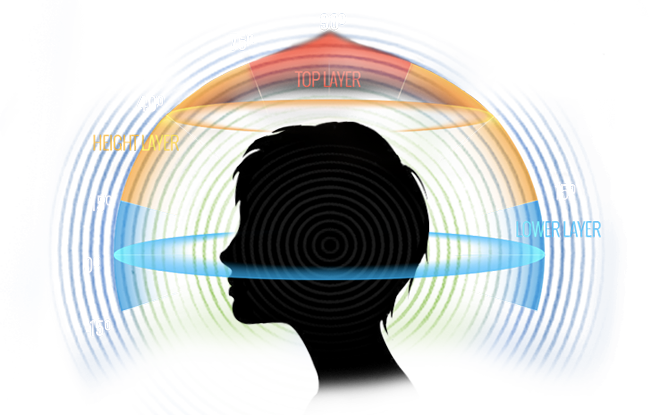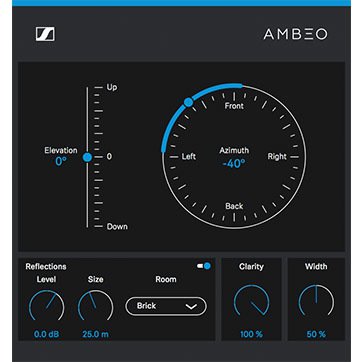To understand how 3D audio (binaural audio) works we need to understand how we perceive the directions of the sounds.

PERCEPTION OF SOUND SOURCE DIRECTION:
How do we perceive the direction that a sound arrives from? The answer is that we make use of our two ears, but how? Because our two ears are separated by our head, this has an acoustic effect which is a function of the direction of the sound. There are two effects of the separation of our ears on the sound wave:
Interaural time difference (ItD)
The ears are separated by about 18cm, so there will be a time difference between the sound arriving at the ear nearest the source and the one further away. When the sound is off to the left, the left ear will receive the sound first, and when it is off to the right, the right ear will hear it first. If the sound is directly in front, or behind, or anywhere on the median plane, the sound will arrive at both ears simultaneously. The time difference between the two ears will depend on the difference in the distances that the two sounds have to travel. A simplistic view might just allow for the fact that the ears are separated by a distance d and therefore calculate the effect of angle on the relative time difference by considering only the extra length introduced due to the angle of incidence.

We also have to estimate the delay between the ears because the sound must travel around the head in order to get to them. This adds an additional delay to the sound.
This is a very small delay but a variation from that small delay, to zero determines the direction of sounds at low frequencies.
This delay varies as a function of angle. Note that there is no difference in the delay between front and back positions at the same angle. This means that we must use different mechanisms and strategies to differentiate between front and back sounds. There is also a frequency limit to the way in which sound direction can be resolved by the ear in this way. This is due to the fact that the ear appears to use the phase shift in the wave caused by the interaural time difference to resolve the direction; that is, the ear measures the phase shift given by:
Interaural intensity difference (IID):
The other cue that is used to detect the direction of the sound is the differing levels of intensity that result at each ear due to the shading effect of the head. In this effect, the levels at each ear are equal when the sound source is on the median plane but that the level at one ear progressively reduces, and increases at the other, as the source moves away from the median plane. The level reduces in the ear that is furthest away from the source.

For the high frequencies, we detect the direction of the sound thanks to the shape of our ears, and their folds. It folds cerate small acoustic shadows at each frequency that our brain, in a long-term period (from the day of our birth) learn and relates to different directions for each freq.
Al these effects has their own equations to calculate all these delays (ITD) and intensities (IID), used to develop algorithms used in binaural or 3600 panner plugins like the Sennheiser’s AMBEO ORBIT or the Waves NX Virtual Mix Room and Abbey Road Studio 3, designed to facilitate mixing immersive binaural content.
With the AMBEO Orbit plugin (the one I work with) you gain full flexibility and control over your binaural recording. You can now effectively position additional mono or stereo sources into the 3D sound field, avoiding the unwanted coloration. In fact, the patented clarity control allows you to choose how much of the binaural coloration to apply. Additionally, the unique interface for creating binaural room reflections allows you to drastically improve spatial accuracy in comparison to a reverb plugin.

That is a binaural mix I did, related with my hobby of recording sound postcards:
And the same mix without the binaural processing: https://soundcloud.com/jordibosch/train-station-on-a-rainy-day/s-1U7vc
REFERENCES AND INTERESTING LINKS:
Robjohns, H. (2014). The End of the Loudness War?. Retrieved from https://www.soundonsound.com/techniques/end-loudness-war
Waves Inc. (2016) . 3D Audio on Headphones: How Does It Work? Retrieved from: https://www.waves.com/3d-audio-on-headphones-how-does-it-work
Wikipedia contributors. (2017). 3D audio effect. In Wikipedia, the free encyclopedia. Wikimedia Foundation, Inc. Retrieved from https://en.wikipedia.org/wiki/3D_audio_effect
Svetilk, J. (2019). 3D audio: Discover the immersive technology that will change the way you experience sound. Retrieved from: https://home.bt.com/tech-gadgets/tv/home-cinema/what-is-3d-audio-11364187350860
Manning, R. [The Verge]. (2015, Feb the 12th). Hear New York City in 3D audio. Retrieved from URL https://www.youtube.com/watch?v=Yd5i7TlpzCk

